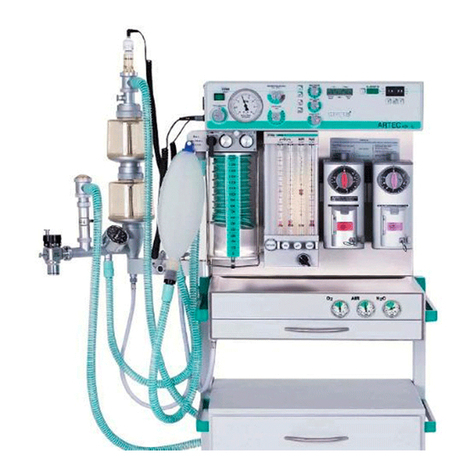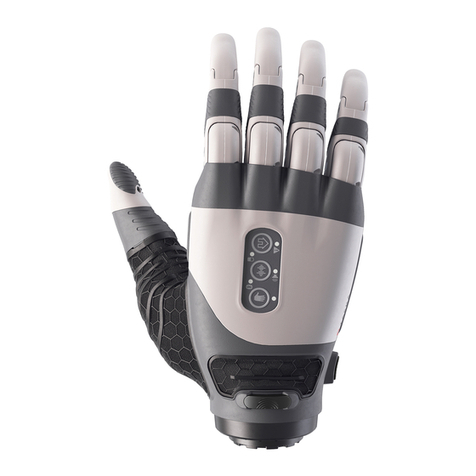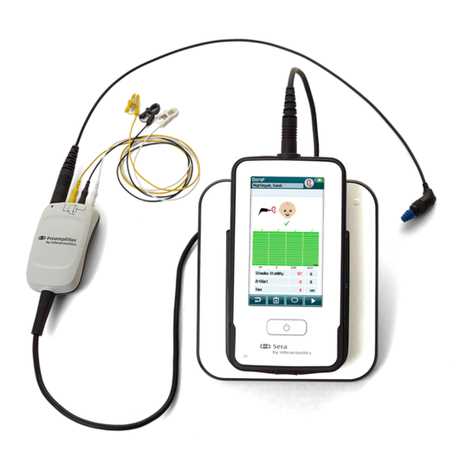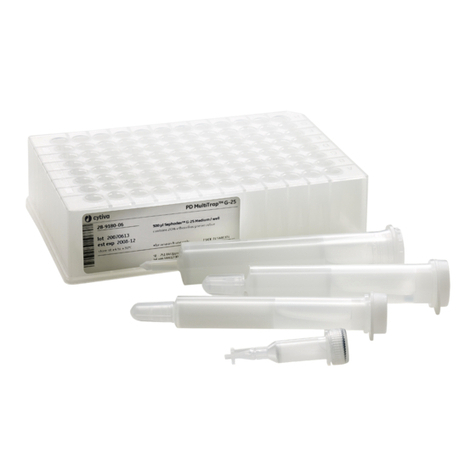Acticare TSE User manual


Acticare IC is manufactured by:
Bioinduction Limited
178-180 Hotwell Road
Bristol BS8 4RP
United Kingdom
Tel: +44 870 241 9071
Website: www.acticare.com
Document REF: TU-00001 IC Manual (3.0)
Part code: C00212
Year of manufacture: 2005
Acticare and the Acticare logo are registered
trademarks of Bioinduction Ltd
The Acticare device is protected by patents
and patents pending. This manual is copyright
© Bioinduction Limited 2004, 2005.
0120
Contra-indications.
Warnings and Cautions.
Important Note.
These notes
describe situations where you should
not use Acticare IC.
Make sure
you understand these before using
Acticare IC.
This symbol
appears next to key points of note.
Key to Symbols used in this Manual
R
O
If you need advice about any aspect of your
Acticare device please visit our website:
www.acticare.com, email us at:
during office hours on 0870 241 9071.
Consult our website for international support
numbers.
Calls may be recorded
for quality control
purposes.
Common problems are
listed in the
troubleshooting guide in
section 10.
Need Help?
Warranty information
Bioinduction Ltd warrants Acticare IC and its
fast charge cradle free from defects in
workmanship and materials for one year from
the date of invoice.
Electrodes, batteries, carry cases, lead wires
and other accessories are warranted to be
free from defects in workmanship or materials
at the time of delivery.
Bioinduction Ltd will repair or replace, at its
discretion, any product found to be defective
within the warranty period.
This warranty does not apply to any product
which has been damaged due to misuse, or
that was repaired or altered other than by the
manufacturer.

Introduction
Important Information
Your Acticare IC
Getting Started
Interferential Mode
TSE Mode
TENS Mode
Advanced Therapy Mode
Maintenance and Care
Troubleshooting
Settings Menu
Technical Information
Quick Reference
10
11
12
1
2
5
6
7
8
9
3
4
This manual had been written
assuming a level of knowledge of
electrotherapy consistent with a
clinician experienced in electrotherapy
techniques.
Acticare IC is intended for use only
under the guidance of a clinician. 13

1
Introduction
1
Your Handheld Electrotherapy System
This manual will instruct you in the use of
Acticare IC. It also contains important
information that you should read thoroughly
before using your device. Acticare IC is a
powerful machine and we recommend that
it is used under the guidance of a clinician
experienced in electrotherapy techniques.
Acticare IC should only be used to treat
conditions that have been diagnosed by a
clinician.
Transcutaneous Spinal Electroanalgesia (TSE)
is a relatively recent innovation in chronic pain
relief, discovered in 1991 by Drs Alex
Macdonald and Tim Coates in Bristol, England.
TSE was inspired by Dorsal Column
Stimulation and has the benefit that no
surgical procedure is required to implant the
electrodes.
TSE uses medium frequency, high voltage
pulses of very short duration - typically less
than 4 millionths of a second (4µs) - applied
to the spinal cord. These pulses modify pain
processing in the central nervous system.
TSE operates at relatively high levels of
current compared to TENS, delivering similar
power to Interferential devices. However, TSE
generates very little peripheral nerve
excitation because of the very short duration
of the pulses.
For more information about TSE visit
www.acticare.com.
About “TSE”
Acticare IC is a fully portable Electrotherapy
System that provides multiple treatment
modalities and a fully programmable
advanced user mode.
Acticare IC is unique in that it delivers the
power output of a professional desktop
electrotherapy machine in a battery powered
device that you can carry in your pocket.
This is achieved using a revolutionary method
of digital waveform synthesis that is far more
efficient than traditional designs.
Standard electrotherapy modalities
incorporated in Acticare IC are:
Interferential Current (IC),
Transcutaneous Electrical Nerve
Stimulation (TENS),
High Frequency TENS (HFT),
Transcutaneous Spinal Electroanalgesia
(TSE).
In addition, the waveform is quickly
programmed via Acticare’s menu system to
provide additional TENS frequencies and the
following modalities:
Acupuncture-like TENS (AL-TENS) down
to 1Hz,
Neuromuscular stimulation (NMES),
Transcutaneous Pulsed Radio-frequency
(PRF) therapy up to 0.5MHz.

2
TENS and TSE are effective for the
symptomatic relief of chronic pain associated
with many conditions including:
Back pain
Arthritis
Chronic musculoskeletal pains
Period pain
Joint and limb pains
Post-operative and post-injury pain
The following are indications for the use of
interferential current therapy:
Treatment of pain in muscles, tendons,
ligaments, capsules or nerves
Muscle stimulation
Increase in blood flow to injured area
Reduction of oedema
Indications Contraindications
Contraindications
Important Information
2
Unknown Cause
Carotid Sinus (Neck Stimulation)
Tumours
Acute Sepsis
Patients who cannot understand
Hypersensitivity
Febrile conditions
Severe hypertension / hypotension
Pyrexia
Tuberculosis
Do not use electrical
stimulation to relieve undiagnosed pains, until
cause has been established by a clinician.
Avoid
using any electrode placement that stimulates
the carotid sinus region at the front of the
neck. In rare cases, spasm of the laryngeal
and pharyngeal muscles may occur when the
electrodes are placed across the neck or
mouth. This may be strong enough to cut off
the airway causing breathing difficulty.
Do not use if a clinician determines
that there is a risk of increased growth or
malignancy. Interferential current
treatments may spread infections. the
nature of the treatment for example young
children or the very elderly.
or fear of electrical
treatments
Cardiac pacemakers
Epilepsy
Transthoracic Stimulation (Chest)
Sensory loss
Skin and vascular problems
Cranial Stimulation (Head)
Not to be used by
persons fitted with a cardiac pacemaker.
Not to be used by persons who
suffer from an epileptic condition. Do
not apply the electrodes transthoracically
(across the chest). This can cause electrical
current to enter the chest and may lead to
irregularities in heart beat.
Do not use on areas of the
body where there is a loss of normal skin
sensation. Do not apply
the electrodes over infected areas of skin, skin
eruptions, dermatological conditions, open
wounds or damaged or broken skin.
Do not apply
the electrodes transcerebrally (across the
head).
Precautions - electrodes
Current Density Limit
TENS and TSE modes.
Current densities of
2
greater than 2mA RMS/cm are not
recommended and may cause burns at the
site of the electrodes. Use the supplied
self-adhesive electrodes only, these have an
internal metallic conductor to provide even
current distribution over the pad. Carbon-
rubber based TENS electrodes are not suitable
as they may overheat.

3
Precautions - electrodes
Important Information
2
Interferential mode
Monophasic and twin peak TENS modes
5cm by 5cm square
self-adhesive electrodes as supplied should
not be used with interferential currents (IC)
greater than 50mA. The optional 6cm by 8cm
solid rubber electrodes may be used with up
to maximum output, but ensure that the
sponge pads are moist before use.
should only be used by qualified persons and
with extreme care.
Warnings
Warnings
Electronic equipment
Spinal Cord Stimulators
High frequency Surgical Equipment
Microwave or Radio frequency sources
Radio frequency equipment
Damage from liquids
Flammable atmospheres
External use
Connections
Changing batteries
Electronic
monitoring equipment such as cardiac alarms
may not function properly if used
simultaneously with this device.
TSE modes or any
stimulation applied over the spine are not
recommended for use in persons with an
implanted spinal cord stimulator.
Simultaneous connection of a patient to high
frequency surgical equipment may cause
burns at the site of electrodes and possible
damage to the device.
Operation close (less than 1m) to sources of
short-wave radio or microwave equipment is
not recommended. The operation
of Acticare IC has associated low levels of
radio frequency emission. In some modes of
operation, when powered via the cradle, this
may be sufficient to affect the operation of
adjacent equipment with low radio frequency
immunity. Do not allow Acticare
to come into contact with water or other
liquids. Do not use in the bathroom.
Do not use this
device in the presence of flammable gases or
liquids, such as when refueling an automobile.
Only for external use. Not for
internal use. Do not connect Acticare IC to
anything other than the approved charger
cradle and electrode lead wires.
Disconnect electrodes
and turn the device off before opening the
battery compartment.
Clinical Guidance
Menstruation
Metal implants
Neurological damage
Keep out of reach of children
Only use Interferential
Current (IC) therapy under the guidance of a
trained clinician. Wrongful use of IC can cause
serious injury or death.
Interferential treatments may
cause increased bleeding or pain.
Discontinue treatment if the
patient experiences unpleasant sensations.
Use only under the
guidance of a clinician for persons with
neurological conditions such as MS, stroke
and cognitive defects.
This device
is not recommended for use on children
except under clinical guidance.
Pregnancy
Drowsiness
Symptomatic treatment
The safety of electrotherapy at
anytime during pregnancy or birth has not
been established.
This device can cause
drowsiness or light-headedness. During use,
or after use if feeling drowsy, never operate
potentially dangerous machinery such as
power tools, automobiles, etc.
This device can
suppress sensations of pain that would
otherwise serve as a protection mechanism.

4
Important Information
Warnings
Adverse reactions
Servicing
2
Uncomfortable stimulation
No curative value T
Long-term effects
Pains of Central Origin
Do not
operate at a level at which the stimulation is
uncomfortable; reduce the intensity to a
comfortable level. his device is effective
for the treatment of chronic pain but has no
curative value. The long-term effects of
chronic use of electrical stimulation have not
been established. TENS is not
effective for pains of central origin (this
includes headache).
Skin irritation under electrodes.
Electrode burns
Adverse reactions
This
usually resolves itself within a few days. A
hypo-allergenic electrode material is available
for sensitive skin. from high intensity
stimulation or mono-phasic currents. Use
large electrodes or biphasic modes and reduce
stimulation level. to electrotherapy are
rare but reported cases include the following:
general malaise, nausea, vomiting, dizziness,
fainting, migraine or headache, epileptic
seizure, eczema, tinnitus, numbness, loss of
muscle tone and balance, swelling or redness.
If affected, discontinue use and seek medical
advice.
This unit contains high voltages. Servicing
should only be undertaken by qualified
personnel or the manufacturer. To comply
with standards in some countries, the device
may require calibration and safety testing on
an annual basis.
To the maximum extent permitted by law,
Bioinduction Ltd, its subsidiaries, suppliers or
resellers (collectively “Bioinduction”) accepts
no liability for any damages arising from the
use of or inability to use the product including
but not limited to indirect, incidental or
consequential damages.
In any event, Bioinduction's entire liability
shall not exceed the purchase price of the
product, with the sole exception of death or
personal injury caused by the negligence of
Bioinduction but only to the extent law
prohibits the limitation of damages in such
cases. The purchaser indemnifies
Bioinduction from all claims arising from third
parties.
Bioinduction will not be held liable for any loss
resulting from incorrect information provided
by its personnel, errors or omissions in this
manual and other documentation.
By using the product the purchaser agrees to
be bound by these terms, otherwise
purchasers should return the product unused
within 14 days of receipt requesting a refund.
Limitation of Liability

3
Acticare IC Device Lead wires (2)
Rechargeable
batteries (4)
Charger & Mains
Power Cradle
Self adhesive
electrodes
(2 packs of 4)
User manual
Carry bag
Before first
use, please
check the
contents of
your package.
Optional
accessories
include rubber
electrodes,
available from
our website.
Your Acticare IC
Features of the Acticare IC unit
Electrode connectors Battery catch
Battery cover
Belt clip
Charger connector
TENS & TSE /
Interferential
Selector Switch
Front View Back View
5
Identifying the Components of Acticare IC
Operating light
User display
On/Off button
Timer button
Plus button
Minus button

3
Display Symbols and Their Meaning
Your Acticare IC
6
Person:
Indicates when treatment starts.
In TSE and TENS modes only,
flashes if electrodes are not
properly connected.
Clock:
Indicates that the treatment
timer is counting down.
Treatment timer:
Shows the remaining treatment
time in hours and minutes and in
seconds for the last minute of
treatment.
Battery:
Indicates the amount of charge
left in the batteries. Flashes
when charging.
Power Bar:
Shows the intensity setting on a
visual scale, each segment
represents 10% output. Top bar
flashes when power output is at
maximum safety current limit.
TSE Mode:
Indicates when the device is in
TSE mode.
IC Mode:
Indicates when the device is in
Interferential Current (IC) mode.
TENS Mode:
Indicates when the device is in
TENS mode.
Intensity setting:
In TSE/TENS mode:
In IC mode:
shows the
intensity (voltage) setting as a
percentage from 0% (off) to
100% (max).shows the intensity
setting as 0-100mA peak into a
standard 500ohm load.
Percent Sign:
Indicates that the intensity
setting is in percent form.
Example Screen (Note: The TENS, TSE and IC symbols are never illuminated together).

Charging Batteries
4
7
Your device is supplied with four AA
rechargeable Nickel Metal Hydride (NiMH)
batteries.
1. Open the battery cover by squeezing the
blue catch as shown.
2. Insert four AA batteries making sure the
polarity is correct. The correct polarity is
indicated by symbols in the battery
compartment.
Installing batteries
Acticare IC can be used for treatment
when it is on the charger stand, but
the batteries will only be charged
when the device is switched off.
The fast charge cradle provides a full charge
in 2½ hours. To charge batteries, plug the
device into the charger stand as shown below.
If you need to use the device straight away,
you can operate from mains power while in
the cradle.
Make sure you push the device fully into the
cradle to ensure proper contact. An
intermittent beeping means that the device is
not pushed completely in.
Using the charger / mains power cradle
The battery symbol will scan to indicate that
the battery is charging. If the battery is not
charging check to make sure the charger is
plugged in and the socket is switched on.
When the batteries are fully charged the
battery symbol shows full.
Battery
Low Battery
Full
3. Close the battery cover. Check that it is
secure. If the batteries are correctly installed
the battery symbol will be displayed
on the screen.

Charging Batteries
8
4
Under typical operating conditions freshly
charged batteries should last for 2-3 hours.
With maximum power treatments freshly
charged batteries should last 1 hour. The
amount of charge left in the batteries is
shown on the battery indicator when the
device is switched on.
Typically, NiMH batteries need replacing after
12 months of continuous use although you
may need to replace them sooner if you are
experiencing poor performance.
When replacing batteries, do not mix old and
new rechargeables or batteries of different
capacity (mA/hour) ratings.
Acticare IC can be used with AA sized alkaline
batteries. You may find this useful if traveling
abroad.
If you plan to store your unit for a period of
longer than a month, it is essential that you
remove the batteries from the unit.
This helps maintain charge and extends useful
life of the batteries.
Never attempt to recharge standard
alkaline batteries. Do not plug
anything into the base of Acticare IC
except for the dedicated Acticare
charger stand.
Battery Lifetime
Using Non-Rechargeable Batteries
Storing Acticare IC

9
5
The four main clinical applications for which
interferential therapy is commonly used are:
pain relief, muscle stimulation, increase of
blood flow and reduction of oedema.
An Amplitude Modulation Frequency (AMF) in
the range of 100-200Hz is generally accepted
to stimulate the pain gate mechanisms,
thereby masking pain symptoms. Stimulation
with lower AMF (1-10Hz) is used to activate
opoid mechanisms. Relief of pain may also be
achieved by blocking C fibre transmission at
AMF higher than 50Hz.
Stimulation of the motor nerves is possible
with a range of AMF. Stimulation at low
frequency (e.g. 1Hz) results in repeated short
contractions, while stimulation at 50Hz will
result in a sustained tetanic contraction. Mild
stimulation below that of sustained tetanic
contraction, with a sweep of 0-25Hz, has been
observed to provide a combination of muscle
stimulation, increase in blood flow and
reduction in oedema.
Pain Relief
Muscle Stimulation
Interferential Mode
Clinical Applications Therapy Modes
Name Carrier Base AMF Peak AMF Pattern Typical Application
PROG2 4kHz 0 25 6^6 Muscle Stimulation
PROG4 4kHz 10 150 6^6 Acute & Chronic Pain
PROG6 4kHz 100 150 6^6 Acute Pain
PROG8 2kHz 0 25 6^6 Muscle Stimulation
PROG1 4kHz 0 10 6^6 Chronic Pain
PROG3 4kHz 0 100 6^6 Increased Circulation
PROG5 4kHz 50 200 6^6 Acute Pain
PROG7 2kHz 0 10 6^6 Muscle Stimulation
VAR 2kHz or 4kHz 0Hz to 250Hz 0Hz to 250Hz 1/1 6/6 6^6
Acticare IC provides two channels of pre-
modulated (two-pole) Interferential Current.
The electronic pre-modulation ensures 100%
modulation across the treatment zone. There
is no quadripolar (four-pole) mode, although
four electrodes can be employed to cover a
large area with the pre-modulated waveform.
Available modes include eight preset
programs plus one fully user programmable
mode as summarised in the table below.
Maximum output is 100mA peak current
(70mA RMS) shared between the two
channels.
For guidance on the use of interferential
therapy consult www.electrotherapy.org.
Typical Interferential Waveform
Programs Available (AMF= Amplitude Modulation Frequency)
-100
-50
0
50
100
Current [mA]
Time [2.5mS/div]

10
Changing Therapy Modes
1. Check the device is in IC Mode
2. Enter the Therapy Mode Menu
(see STEP 1
on page 11). Turn the device on by pressing
and releasing the on/off button .
by pressing
the and TIMER buttons
. The display flashes “MODE
MENU” as confirmation.
together at the
same time
Interferential Mode
3. Press or to select the desired
program
4. If you choose the variable user
programmed mode (VAR)
5. Save your VAR program parameters and
exit Therapy Mode
from the table opposite. If you
choose a preset program press and hold
TIMER to confirm your selection and exit
the Therapy Mode menu.
you will need to
set the treatment parameters in the following
order: Carrier frequency, Base Amplitude
Modulated Frequency (AMF), Peak AMF,
Sweep pattern. See the diagram above right.
Scroll through parameters using the TIMER
key and alter the parameter value using the
or keys.
Pressing the TIMER key continuously will
cycle through the parameters so you can
make any changes or check them.
menu by pressing and
holding the TIMER button. To cancel the
new settings press and TIMER together.
You can check the settings by swithcing the
device off and on using .
Example Screen
Variable (VAR) Mode Menus
Parameter
Carrier Frequency
2kHz or 4kHz
Base Amplitude
Modulated
Frequency (AMF)
0Hz - 250Hz
Peak Amplitude
Modulated
Frequency (AMF)
0Hz - 250Hz
Sweep Pattern
6^6, 6/6, or 1/1
Sweep Pattern Options
Peak
Peak
Peak
Base
Base
Base
0
0
0
51 6
1
6
11 1712
2
12 18
18
3
Time (seconds)
Time (seconds)
Time (seconds)
AMFAMFAMF
6/6
1/1
6^6
For a constant sine wave output at
the carrier frequency, set peak and
base at 0Hz in VAR mode.
If you see the timer
screen instead of the
mode menu, you did
not press &
together. Press
to exit & try again. 5

11
Switch the Therapy Mode Switch on the
underside of the unit to the IC position.
STEP 1. Select IC Mode
When the Therapy Mode Switch is changed,
the device automatically switches off. The
“IC” symbol will be illuminated next time
Acticare IC is turned on to show that Acticare
IC is now in IC mode.
IC Icon
Caution. Only use Interferential
Current (IC) therapy under the
guidance of a qualified practitioner.
Wrongful use of IC can cause
serious injury or death.
STEP 2. Connect the electrodes
and lead wire(s)
1. Decide whether you are using one or two
channels.
2. If you are using one channel, connect the
small pins on the end of one lead wire to two
self adhesive or the optional rubber electrodes
illustrated. If you are using two channels
repeat this with another lead wire. Self-
adhesive electrodes are recommended only
for stimulation levels below 50mA indicated.
3. Connect the lead wire(s) to the main unit.
If you are using only one channel, pick either
connector slot and leave the other empty.
Using IC mode
Simply follow the steps outlined over the next
few pages.
5
Interferential Mode
Therapy Mode Switch
TSE & TENS IC

12
Note that the connector can only be inserted
into the main unit in one orientation. For the
right orientation, match up the key shape of
the connector with the key shaped hole in the
main unit.
4. If using the optional carbon rubber
electrodes, insert the electrodes into damp
sponge holders.
Apply the electrodes in the appropriate
position. If using rubber electrodes they may
be attached using surgical tape or double
sided velcro bandages available from our
website. Make sure that the area requiring
treatment is between the pair of electrodes
from one lead wire. The electrode positioning
should always be determined by a skilled
therapist.
If using two channels remember that the
channels are not isolated from each other.
Take care to ensure that the electrodes are
positioned so that current cannot flow across
the chest even in the event that one of a pair
of electrodes falls off.
STEP 3. Apply the electrodes.
5
Interferential Mode
STEP 4. Turn on Acticare IC.
Press and release the ON/OFF button to
turn on the main unit. The current mode will
be displayed. If in VAR mode a scrolling list of
the current settings will also be shown.
If you wish you can change the therapy mode
at this point. Press and TIMER together
to enter the Therapy Mode menu and follow
the instructions on page 10.
Check that the IC icon is shown to indicate
that the device is in interferential mode.
Press +
to begin
treatment
Mode
Display
(2 secs)
Power Up Sequence
Caution. Acticare IC is as powerful
as most mains powered desktop
electrotherapy equipment despite its
small size. Make sure that the
electrodes are paired up correctly,
with the treatment area(s) positioned
between a pair of electrodes
attached to the same lead wire.
Ensure that current cannot flow
through or across the chest or head.
IC Icon

13
Timer Screen
When prompted by the message “PRESS + TO
BEGIN TREATMENT”, press the plus key to
increase the treatment intensity to the desired
level from 0mA (off) to 100mA peak
(maximum). Each press of the key
increases the intensity by 1mA, holding the
key down causes the intensity to increase
gradually without the need for repeated
presses.
During treatment, the running screen will be
displayed indicating the intensity setting.
Also, the orange light on the top of the unit
will turn on to show that the treatment has
begun.
The intensity is displayed as a figure from 0-
100mA peak at the bottom left of the screen
and as a bar graph at the top left, where each
segment represents 10mA.
If sensation
uncomfortable, press the key until it is
comfortable again.
any tingling becomes
Skip this step if you wish to use the last used
treatment time which is automatically
displayed when you start treatment.
There is no universal recommended treatment
time for interferential current treatments.
Treatment times as long as 30 minutes can be
used if required in practice.
To adjust the treatment time, press the TIMER
button. The Timer screen will then be
displayed showing the last used treatment
time.
Press or to increase or decrease the
timer to the desired time. You can select
times between 1 and 30 minutes, or disable
the timer.
Press and hold the TIMER button to
confirm your setting. Acticare IC will then
display the Intensity screen with your new
treatment time shown.
5
Interferential Mode
STEP 5. Set the treatment time
Typical Running Screen
Caution. Take care not to exceed
2
the 2mA RMS / cm current density
limit at the electrodes. 5cm square
self-adhesive electrodes should not
be used above 50mA indicated.
Instead use the optional carbon
rubber electrodes available from our
website.
STEP 6. Commence treatment
Intensity Level
Bar Graph
Intensity Level (mA) Treatment Timer

14
STEP 7. Changing parameters during
a treatment
You can easily change treatment parameters
in the middle of a treatment.
1. Pressing and TIMER keys together
during treatment enters the Therapy Mode
menu.
2. Change settings as described on page 10.
3. To cancel your actions press and TIMER
together.
4. To save your settings and exit Therapy
Mode menu press and hold the TIMER
button. This will cancel the current treatment
and reset the treatment timer.
Press or to increase or decrease the
intensity during treatment.
1. Press TIMER .
2. Pressing or will then increase or
decrease treatment timer from its current
value.
3. To confirm new time press TIMER again.
Once your change has been confirmed
Acticare IC will return to the running state
with the timer counting down and the
intensity you originally set.
Changing treatment programs during
treatment:
Changing the intensity during
treatment:
Increasing or decreasing the timer
during treatment
5
Interferential Mode
STEP 8. Ending a treatment session
Treatment has ended when the timer has
finished counting down and the message
“TREATMENT COMPLETE” is displayed.
You can end a treatment before the timer has
finished by turning off the main unit.
To turn off the main unit hold down the
ON/OFF button for 1 second.

15
TSE Mode
6
Transcutaneous Spinal Electroanalgesia (TSE)
is a relatively recent innovation in chronic pain
relief, discovered in 1991. It employs very
short (typically less than 4µs), medium
frequency, high voltage pulses applied to the
spinal cord. TSE was inspired by Dorsal
Column Stimulation and has the benefit that
no surgical procedure is required to implant
the electrodes.
Using TSE is easier than TENS since there are
only two electrode placements to consider.
Correct electrode placement is one of the
major reasons that users of TENS experience
difficulties in early use. To get started, follow
the steps summarised in the flowchart below
as described in detail in the next pages.
Getting started with TSE
Commence treatment b
treatment intensity until a light tingling
sensation 100% .
y pressing and
holding down the button to increase the
is felt or is reached
Typical settings are 50% with electrodes on
the neck and 100% with electrodes on the
back in TSE 1 (the default mode).
Treatment ends when the timer finishes
counting down and the message
“Treatment Complete” is displayed.
Plug the lead wire into the top of the
device and connect to two electrodes.
Stick the electrodes on the skin in one
of the two positions shown on page 18.
Turn on Acticare TSE by pressing and
releasing the ON / OFF button.
Acticare IC has three different TSE therapy
modes. First time users should use TSE 1
therapy mode for pain relief. Acticare IC
comes set in TSE 1 mode as standard so you
should not need to change these settings on
first use. When the device is switched on the
set mode is displayed on the screen for 1
second.
TSE modes
We recommend the use of self-adhesive
electrodes for TSE treatments. Low resistance
metallic conductor based electrodes are
required. Standard carbon TENS electrodes
are not suitable due to their poor current
distribution at the relatively high currents
employed by TSE.
Selecting a treatment time & intensity
With TSE, there is no one treatment time
appropriate for everybody. Because of this,
we recommend that users follow the
treatment schedule below for the first two
weeks of using TSE.
Start with a 30 minute
treatment using the default TSE mode called
TSE 1. Set the treatment intensity at a mild
First time use:
Name Therapy Recommended For
TSE 2 Powerful TSE Severe or long-
lasting conditions
where TSE 1 has
not helped.
TSE 1 Normal TSE All first time users,
all conditions.
TSE 3 Long pulse Low mood, fatigue
TSE and conditions where
TSE 1 & 2 have not
helped.

6
16
TSE Mode
tingling level at first; this usually dissipates as
the peripheral nerves accommodate.
If there is no relief, immediately restart the
treatment for another 30 minutes at a higher
intensity with a continuous tingling sensation.
If relief is experienced, note the time and use
this as a basis for the next session.
Many patients find that they experience relief
after 30-60 minutes, with one or two sessions
per day. However, it is safe for patients to
use the device for as long and as often as is
required to gain relief.
Pain
relief with TSE is often cumulative, so in
regular use it is possible for users to
experiment with gradually reducing the length
of repeated treatments.
However, if there is no relief by the end of
treatment, either repeat the treatment at a
higher intensity, or add up to 30 minutes to
the next session.
A typical user experiences
relief with TSE using 30 minute treatments.
Some only need 20 minute treatments,
whereas others with long-standing and severe
pains may require 3 hour treatments.
If there is no relief even using 3 hour
treatments, repeat the two week schedule
using the more powerful TSE mode TSE 2.
If TSE 2 is ineffective, try TSE 3. TSE 3
produces a quite strong tingling sensation
because of its longer pulses and may also be
applied peripherally over the area of pain like
a high-powered TENS machine.
Finding the best treatment time:
Long term use:
4. Press and hold the TIMER button for 1
second to exit and save settings when the
mode you wish to use is displayed. Or press
TIMER and to exit and discard changes.
Changing therapy mode to TSE 2,3 etc.
1. Check the Therapy Mode Switch
2. Enter the Therapy Mode Menu
on the
underside of the device is in the “TSE”
position and turn on Acticare TSE by pressing
and releasing the on/off button .
by pressing
the and TIMER buttons
. The display flashes “MODE
MENU” as confirmation.
together at the
same time
3. Press or to select the mode you wish
to use. Note that you can select any of the
three “TSE”, six “TENS” and two High
Frequency TENS “HFT” modes, or the
advanced settings mode “ADV”.
On/Off
button Timer
button
Plus button
Minus button
Use the and
keys to cycle
through available
modes TSE 1,2,3 etc.
You can check your setting by turning
Acticare off then on. The therapy
mode is displayed on power up.
If you see the timer
screen instead of the
mode menu, you did
not press &
together. Press
to exit & try again.

6
17
TSE Mode
3. Connect the lead wire to the Acticare IC
device. Note that the connector can only be
inserted into the device in one orientation. For
the right orientation, match up the key shape
of the connector with the key shaped hole in
the device.
4. When ready to begin treatment peel the
electrodes off the backing sheet using the
electrode material, not the lead wire. Pulling
on the lead wire can reduce the lifetime of the
electrodes.
Connect a pair of self-adhesive electrodes to
the device using the lead wire as described
below.
for the first
time, pull the wires apart so that the
electrodes can be positioned someway apart
from one another. To do this, slide down the
clear plastic sheath on the lead wire and pull
apart the pins as shown in the picture.
Note: Do not use carbon-rubber TENS
electrodes in TSE mode as they may overheat.
1. Before connecting the lead wire
2. Connect the metal pins to the electrodes
whilst they are still on the backing sheet.
Electrode life is considerably shortened by use on dirty or oily skin; it is best to clean
the electrode application area with soap and water, then rinse and thoroughly dry
before each session.
Do not use worn-out self-adhesive electrodes as this can cause weak stimulation and
skin irritation. With normal use (one treatment per day) electrodes begin to lose their
stickiness after 1 month. Replace with new electrodes when this occurs.
1
3
2
4
STEP 1. Connect the electrodes and lead wire
This manual suits for next models
1
Table of contents
Popular Medical Equipment manuals by other brands
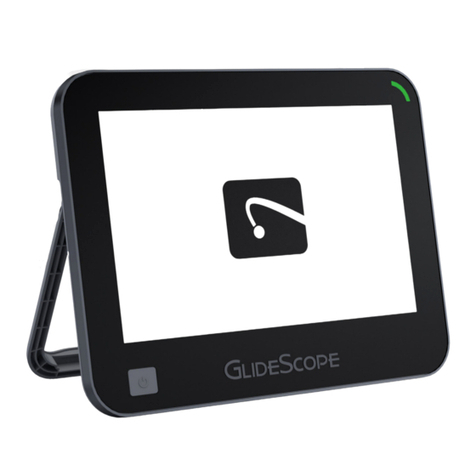
Verathon
Verathon GlideScope Operation & maintenance manual
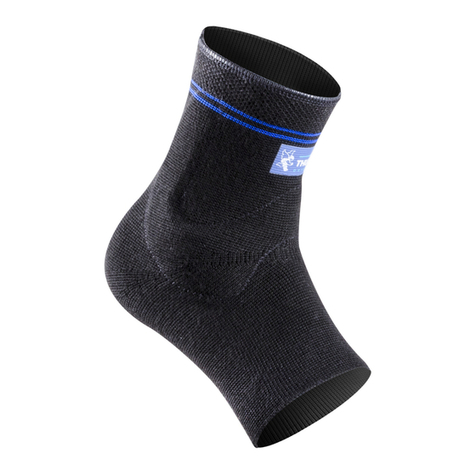
Thuasne
Thuasne Silistab Malleo manual
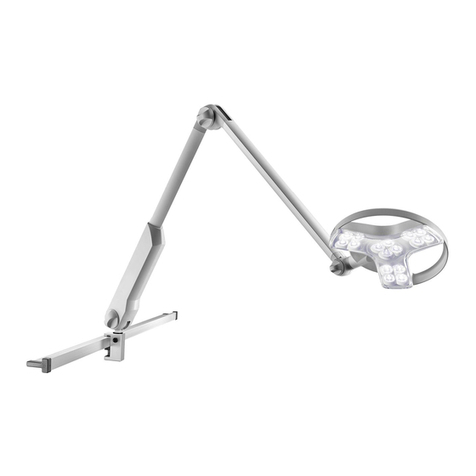
Amico
Amico Gamma LED Series Operating and maintenance instructions
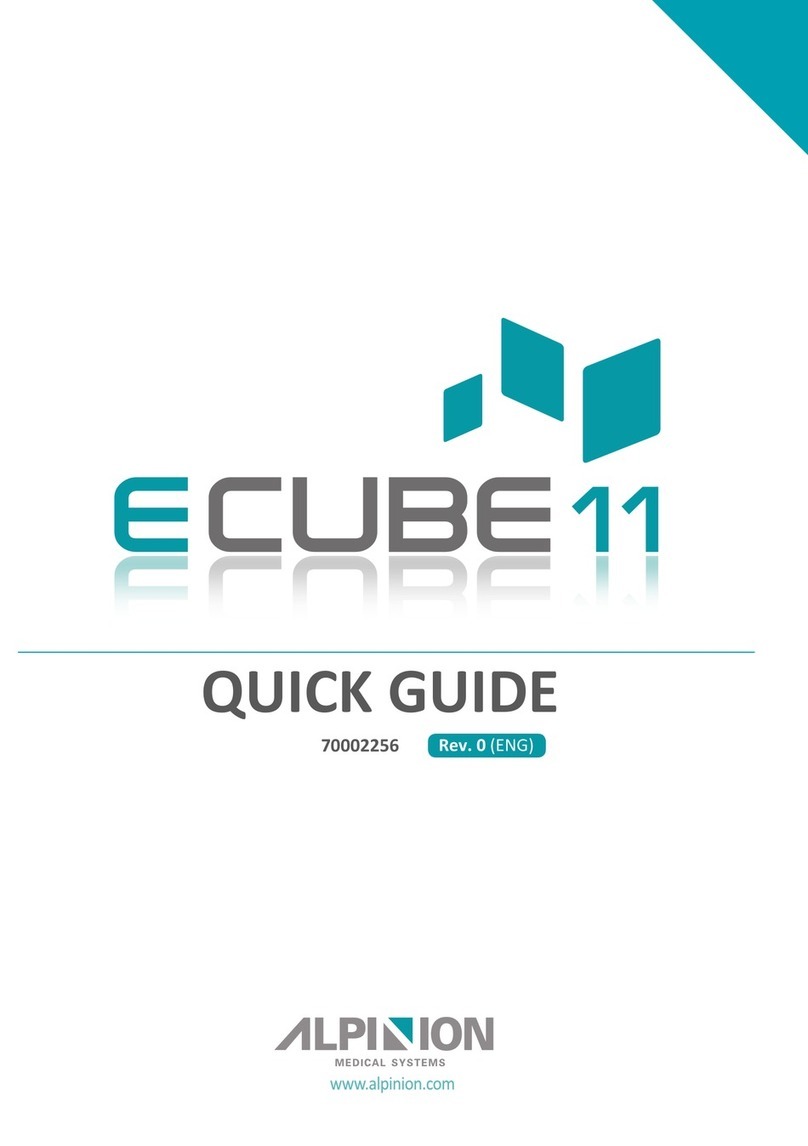
Alpinion Medical Systems
Alpinion Medical Systems E CUBE 11 quick guide
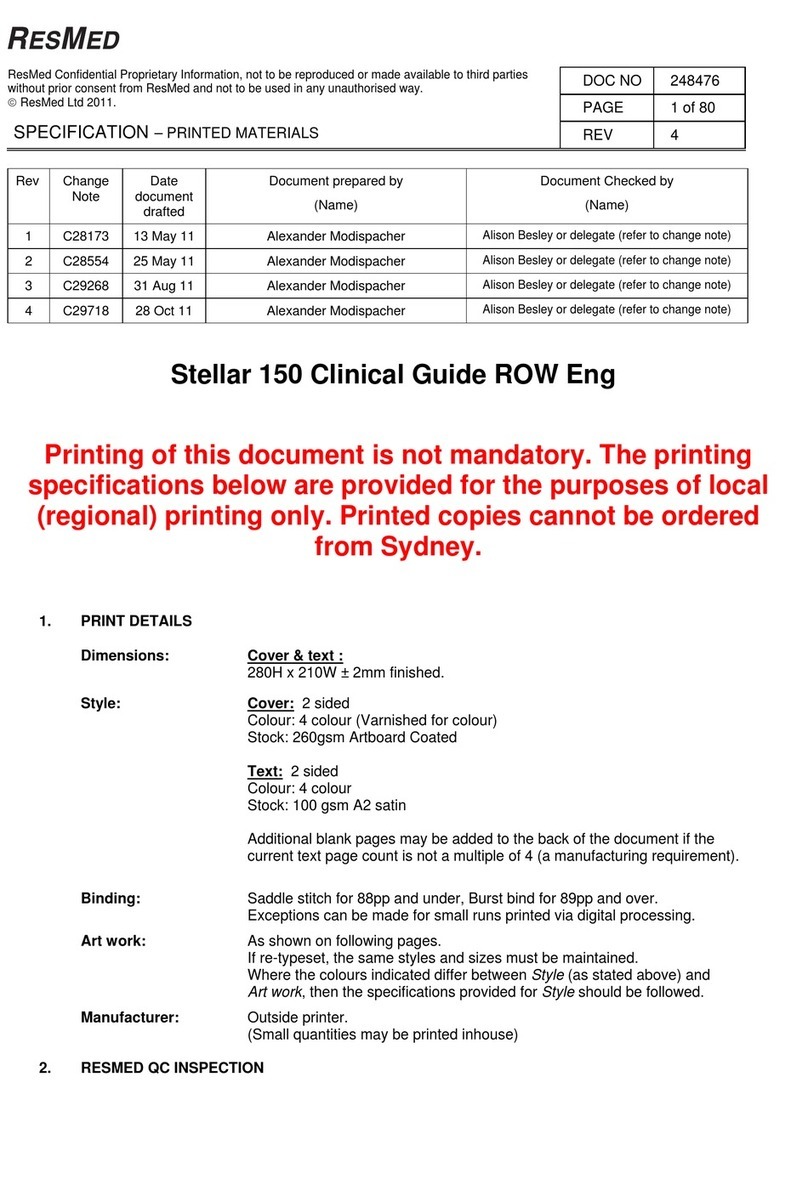
ResMed
ResMed C28173 manual
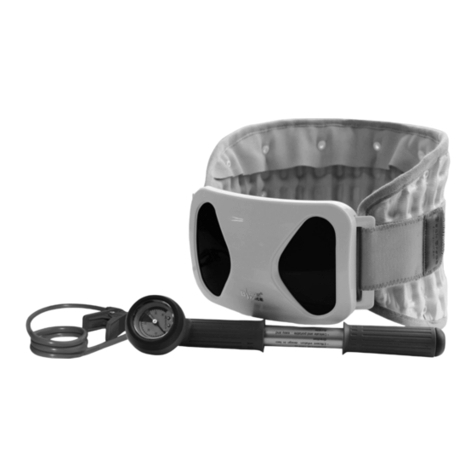
Theratrac Pro
Theratrac Pro LT100 instruction manual
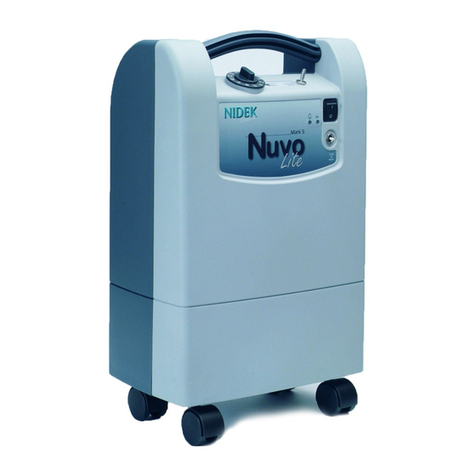
Nidek Medical
Nidek Medical Mark 5 Nuvo Lite Family user guide

Pneumex
Pneumex PneuVest Ultima instructions
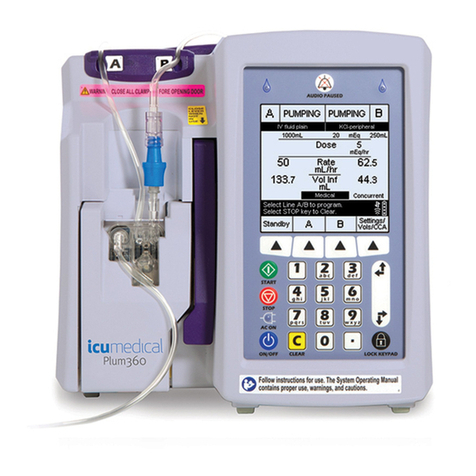
ICU Medical
ICU Medical Plum 360 Technical & service manual

Enraf Nonius
Enraf Nonius Curapuls 970 operating instructions
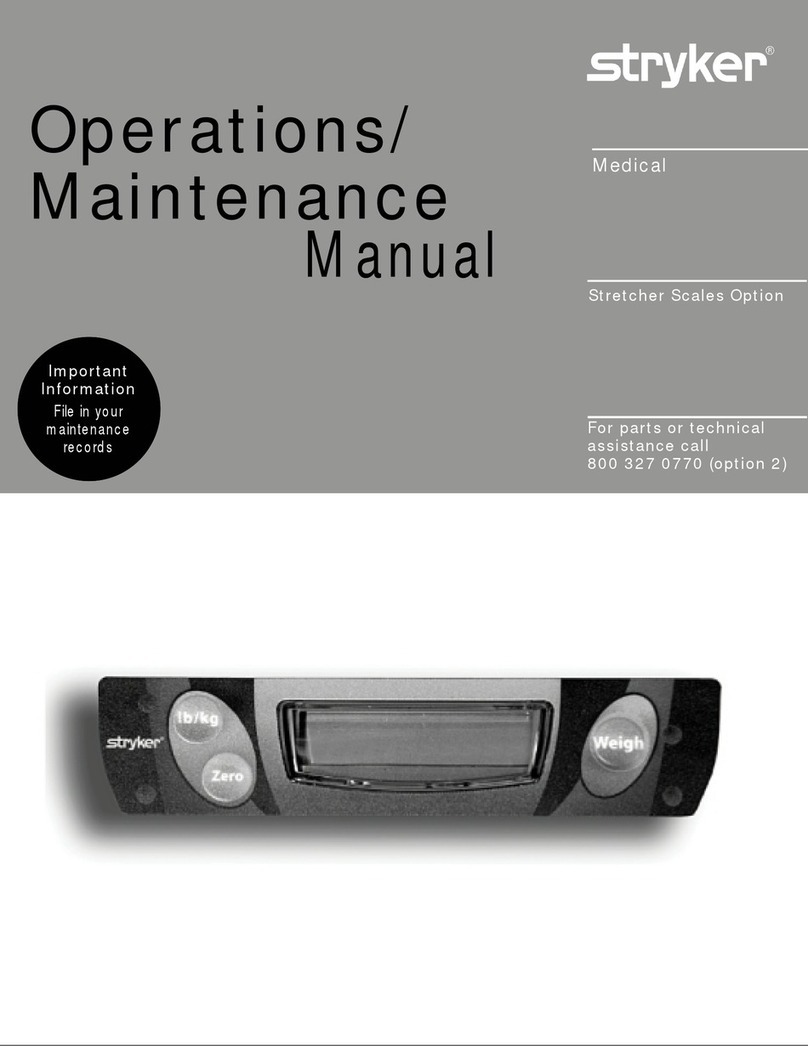
Stryker
Stryker GOLD Operation & maintenance manual

LUMENIS
LUMENIS UltraPulse Operator's manual

